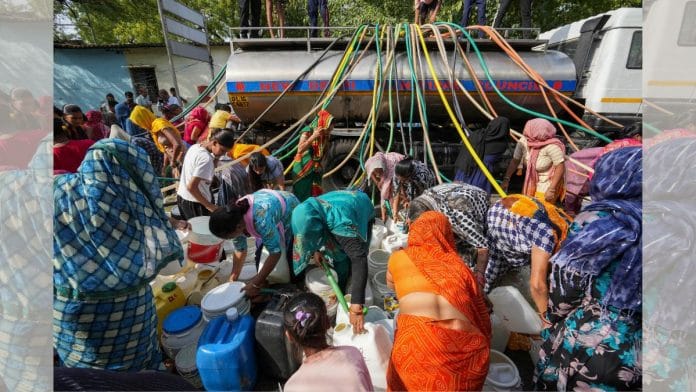New Delhi: The Delhi government Thursday told the Supreme Court that the court can appoint an independent committee to ensure the effective supply of water by the state of Haryana to Delhi, and its efficient usage once the water arrives in Delhi.
In a status report filed Wednesday in the case concerning the water crisis in the national capital, the Delhi government submitted, “Such an independent committee can provide a long- term solution to the recurring problem of water shortage at least in the summer months in the NCT of Delhi.”
“The Petitioner (Delhi government) is making this offer and inviting an order of this Court in the pursuit of the highest amount of transparency that must exist on issues of public resources which are meant for the use of the public at large,” it added.
The Supreme Court Thursday disposed of the Delhi government’s plea seeking directions to Haryana for an immediate release of water to the crisis-hit national capital. In doing so, the court directed the Delhi government to approach the Upper Yamuna River Board (UYRB) by 5 pm.
“The issue should be left to be considered by the body constituted with the agreement of parties in MOU dated 1994. Since the Upper Yamuna River Board (UYRB) has already directed Delhi to submit an application for the supply of an additional 150 cusecs of water on humanitarian grounds, such an application [should] be made, if not already made, today, by 5 pm,” the vacation bench comprising Justices Prashant Kumar Mishra and Prasanna B Varale ordered, Live Law reported.
The UYRB has been asked to then convene a meeting Friday and take a decision on the matter at the earliest. The bench asserted that, if needed, the UYRB can even convene meetings on a day-to-day basis.
Earlier, on 6 June, the Supreme Court had directed the Himachal Pradesh government to transfer 137 cusecs of water to the Hathnikund barrage in Haryana and asked the Haryana government to facilitate the transfer of the surplus water received from Himachal Pradesh to Delhi. This was after it took note of the Himachal Pradesh government’s stand that it had additional water.
On Thursday, however, the court was told by the Himachal Pradesh government that its earlier statement on the availability of 137 cusecs of water was “not correct” and that it should be “permitted to withdraw the statement”.
“In the view of the statement made by the AG (advocate general) of HP, the very basis of our interim order of June 6 2024 does not survive, and we have reached square one to the stage where we were placed on the date of filing the writ petition,” the court then observed.
Also read: Grace marks cancelled, but concerns of NEET aspirants’ remain — ‘paper leak was main issue’
Technology for live water usage updates
The Delhi government’s affidavit also listed the measures already taken and proposed measures to be taken to reduce distribution losses of water in Delhi. This included detailed steps to prevent non-essential usage of water, reduce distribution losses, augment the availability of water, disconnect illegal usage of water, and reduce private water tankers.
On Wednesday, during the hearing, the Supreme Court also raised serious concerns over the loss of water in Delhi due to several factors, including a “tanker mafia”.
The Delhi government’s affidavit, while addressing these allegations, asserts, “The tanker mafia is operational on the Haryana side of the Yamuna river, and the Petitioner lacks jurisdiction to act against the same. It is for Haryana to explain what steps it is taking to preserve the full supply of water to Delhi between the point of release and the point of receipt”.
The Delhi government also told the Supreme Court that the Delhi Jal Board (DJB) has prepared a comprehensive blueprint for augmenting water supplies in the National Capital Territory (NTC) of Delhi by keeping in mind the water scarcity faced by Delhi every year and the sharp rise in population in the city. It also told the court that this plan could be implemented by next year.
The DJB’s blueprint for augmenting water supplies included measures for groundwater augmentation and utilisation of treated water through the development of lakes, installation of borewells and appropriate ammonia treatment plants, and rejuvenation of water bodies. It has also suggested Internet of Things-based monitoring.
The Delhi government also told the court that DJB was in the process of creating a Supervisory Control and Data Acquisition-based system, in order to use appropriate technology that can give live updates of water usage on dashboards.
(Edited by Rohan Manoj)
Also read: Case files in sink, no AC or water supply — Delhi’s consumer forums crumble with massive pendency






